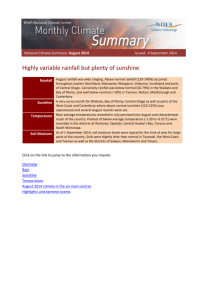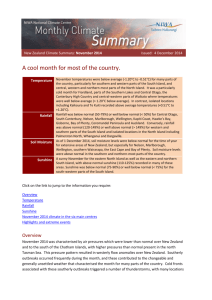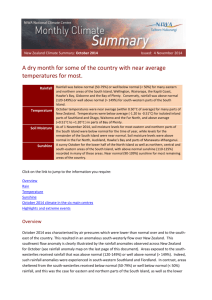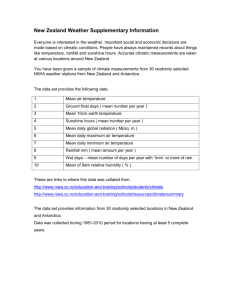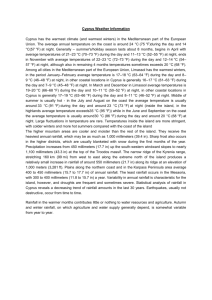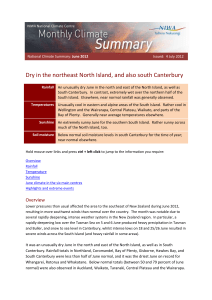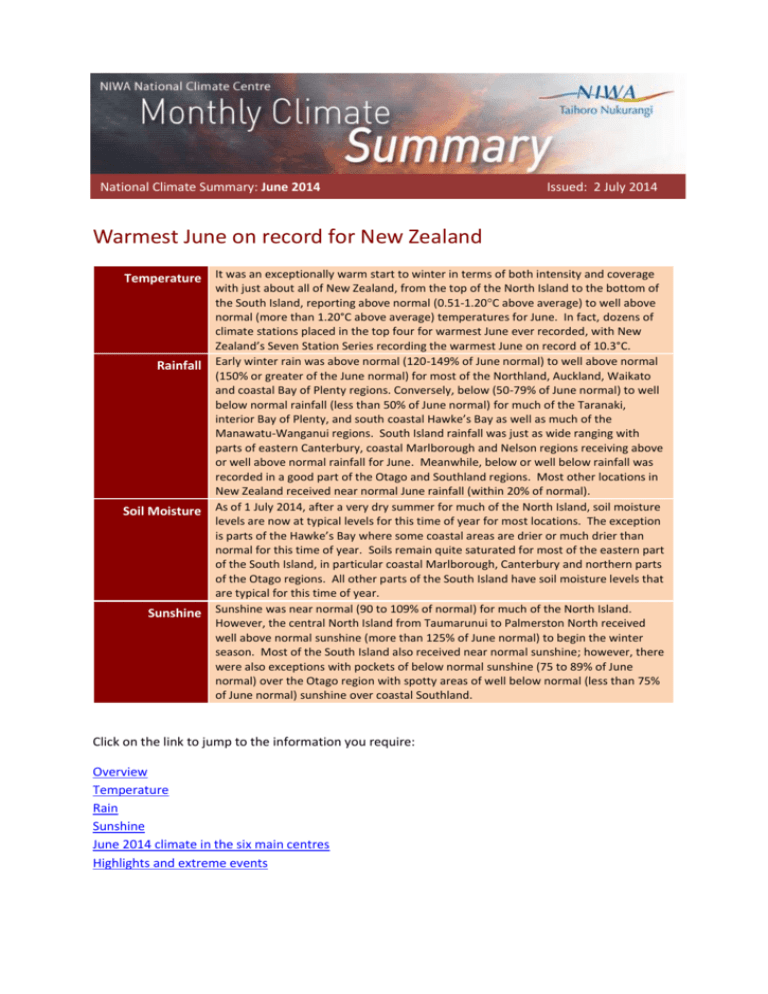
National Climate Summary: June 2014
Issued: 2 July 2014
Warmest June on record for New Zealand
Temperature It was an exceptionally warm start to winter in terms of both intensity and coverage
Rainfall
Soil Moisture
Sunshine
with just about all of New Zealand, from the top of the North Island to the bottom of
the South Island, reporting above normal (0.51-1.20°C above average) to well above
normal (more than 1.20°C above average) temperatures for June. In fact, dozens of
climate stations placed in the top four for warmest June ever recorded, with New
Zealand’s Seven Station Series recording the warmest June on record of 10.3°C.
Early winter rain was above normal (120-149% of June normal) to well above normal
(150% or greater of the June normal) for most of the Northland, Auckland, Waikato
and coastal Bay of Plenty regions. Conversely, below (50-79% of June normal) to well
below normal rainfall (less than 50% of June normal) for much of the Taranaki,
interior Bay of Plenty, and south coastal Hawke’s Bay as well as much of the
Manawatu-Wanganui regions. South Island rainfall was just as wide ranging with
parts of eastern Canterbury, coastal Marlborough and Nelson regions receiving above
or well above normal rainfall for June. Meanwhile, below or well below rainfall was
recorded in a good part of the Otago and Southland regions. Most other locations in
New Zealand received near normal June rainfall (within 20% of normal).
As of 1 July 2014, after a very dry summer for much of the North Island, soil moisture
levels are now at typical levels for this time of year for most locations. The exception
is parts of the Hawke’s Bay where some coastal areas are drier or much drier than
normal for this time of year. Soils remain quite saturated for most of the eastern part
of the South Island, in particular coastal Marlborough, Canterbury and northern parts
of the Otago regions. All other parts of the South Island have soil moisture levels that
are typical for this time of year.
Sunshine was near normal (90 to 109% of normal) for much of the North Island.
However, the central North Island from Taumarunui to Palmerston North received
well above normal sunshine (more than 125% of June normal) to begin the winter
season. Most of the South Island also received near normal sunshine; however, there
were also exceptions with pockets of below normal sunshine (75 to 89% of June
normal) over the Otago region with spotty areas of well below normal (less than 75%
of June normal) sunshine over coastal Southland.
Click on the link to jump to the information you require:
Overview
Temperature
Rain
Sunshine
June 2014 climate in the six main centres
Highlights and extreme events
Overview
June 2014 was characterised by higher than normal mean sea level pressure (MSLP) values from
New Zealand, and in particular, points east and southeast of the country to the Dateline. Meanwhile,
lower than normal MSLP were present to the west and southwest of New Zealand. This resulted in a
dominant north-easterly flow anomaly across the country. Furthermore, this played a significant
role in the record warm June, and start to the winter season, as this meant the source origin of air
was not from the higher latitudes where colder air is generated.
The persistent lack of southerlies not only had a profound impact on the monthly temperatures in
terms of the strength, or departure from average, but also the coverage. In fact, only one climate
station (Middlemarch) experienced a June mean temperature that was NOT either above average
(0.51 to 1.2°C above June average) or well above average (more than 1.2°C above June average). As
highlighted in the temperature section of this document, dozens of locations experienced record or
near record warm temperatures in June.
As for rainfall, there was quite a contrast in terms of distribution across the country. Many northern
and eastern parts of the North Island received above normal or well above normal rainfall for June
(110-125% of normal and greater than 125% of normal, respectively) from Northland to Auckland
and Bay of Plenty regions. However, rainfall was lacking for many other parts of the North Island, in
particular the Taranaki, Manawatu-Wanganui, Wairarapa and southern coastal areas of the Hawke’s
Bay regions where rainfall was below normal (50-79% of June normal) or well below normal (less
than 50% of June normal). No doubt the prevailing north-easterly wind, described earlier, carrying
warmth and moisture from the sub-tropics and tropics, substantially contributed to this rainfall
pattern as northern and eastern areas first greeted the moist air and thus releasing much of its
water content in said areas. Moreover, it is distinctly possible - if not likely - that rainfall was further
enhanced by abnormally warm sea surface temperatures (up to 1.0°C above normal) east of New
Zealand as that provided additional fuel for low pressure centres. The wet impacts of the northeast
wind then reversed as the air continued to travel southwest (from the northeast), drying significantly
by the time it reached central and southern parts of the island.
The rainfall dichotomy continued across the Cook Strait and onto the South Island where
precipitation ranged from above normal to well above normal from the Tasman and Marlborough
regions south into eastern Canterbury and continuing to the Christchurch region. Interestingly, just
southeast of Christchurch, on the Banks Peninsula, rainfall was very low with Akaroa receiving only
one-third of the June normal rainfall, or well below normal (less than 50% of June normal). The
checkerboard pattern continued farther south into the rest of the South Island as woven into a
regime of below normal or well below normal rainfall were areas of normal to even well above
normal rainfall. Of note were many Southland areas that experienced an unusually dry June, with
several locations reporting below or well below normal June rainfall. A relative lack of onshore
(south to southwest) airflow is likely to be a contributing factor to these observations.
In spite of the somewhat erratic nature of the June rainfall distribution, soil moisture levels were
more uniform, though regions of abnormally wet or dry soils were present. As of 1 July, most of the
country has soil moisture levels that are, generally speaking, close to normal (i.e. near field capacity)
for this time of year. The exceptions are on eastern areas of both islands where parts of Hawke’s
Bay, coastal Wairarapa are reporting soil moisture levels that abnormally dry for this time of year.
For the South Island, abnormally wet soils for this time of year are present from the eastern
Marlborough south through to coastal Otago regions.
Near normal (within 10% of June normal) or above normal (110-125% of June normal) June sunshine
hours were recorded for most parts of the North Island. There were even few locations that
experienced well above average sunshine for the month (more than 125% of June normal), mostly in
the Manawatu-Whanganui region. Sunshine for the South Island was, on average, comparatively
less plentiful. Much of the island experienced near normal (within 10% of June normal) or below
normal sunshine (75-89% of June normal), with well below normal sunshine recorded in Nelson (less
than 75% of June normal). However, nestled within that zone was Cheviot in northern Canterbury,
which received well above normal sunshine for June. Well above normal sunshine was also
experienced in Queenstown.
Further Highlights:
The highest temperature was 22.2°C, observed at Waione on 8 June.
The lowest temperature was -7.4°C, observed at Hanmer Forest on 1 June.
The highest 1-day rainfall was 137 mm, recorded at Te Puke on 11 June.
The highest wind gust was 161 km/hr, observed at Cape Turnagain on 21 June.
Of the six main centres in June 2014, Dunedin was the driest and cloudiest, Auckland was
the sunniest and warmest, Tauranga was the wettest, and Christchurch was the coolest.
Of the available, regularly reporting sunshine observation sites, the sunniest four centres1 so
far in 2014 (January to June) are: Whakatane (1392 hours), Tauranga (1261 hours), Auckland
- Albany (1214 hours) and Takaka (1207 hours).
For further information, please contact:
Mr Chris Brandolino
NIWA Forecaster – NIWA National Climate Centre
Tel. 09 375 6335, Mobile (027) 886 0014
Temperature: Warmest June on record for New Zealand
It was an exceptionally warm start to winter from the top of the North Island to the bottom of the
South Island, as dozens of locations experienced record or near record high mean temperatures for
the month of June. As noted in the table below, there are an abundance of individual locations that
recorded their warmest June on record. Of particular note are the number of stations that recorded
temperatures of two degrees or more above the long term average. Perhaps most impressive is how
wide reaching and sustained the warmth was during June. According to NIWA’s seven station
temperature series, June 2014 produced the highest mean temperature for June recorded in New
Zealand. The nation-wide average temperature in June 2014 was 10.3°C (1.9°C above the 1971-2000
June average from NIWA’s seven station temperature series which begins in 1909)2. This surpasses
the previous record for warmest June in 2003, when the temperature anomaly for the month was
1.8°C. Also of note, there have now been nine Junes since 1909 where the departure from average
1
2
New Plymouth sunshine is still omitted from this ranking while recent instrumentation changes are assessed.
Interim value
has been greater than 1.0°C. Of those 9 instances, 5 have occurred since the year 2000 and 8 since
the year 1970.
Record3 or near-record mean air temperatures for June were recorded at:
Location
High records or near-records
Cape Reinga
Kaitaia
Kerikeri
Kaikohe
Whangarei
Whangaparaoa
Auckland (Whenuapai)
Tauranga
Te Puke
Whakatane
Rotorua
Taupo
Motu
Auckland (Mangere)
Pukekohe
Hamilton (Ruakura)
Port Taharoa
New Plymouth
Masterton
Dannevirke
Waione
Ngawi
Hicks Bay
Gisborne
Mahia
Paraparaumu
Palmerston North
Levin
Wellington
Wallaceville
Stratford
Hawera
Wanganui
Takaka
Farewell Spit
Mean
air temp.
(oC)
Departure
from
normal (oC)
Year
records
began
14.9
14.5
14.0
13.7
14.1
13.8
12.7
13.1
12.7
11.4
10.0
8.9
8.7
13.6
12.8
11.9
13.5
12.1
9.8
10.0
10.6
13.0
13.5
12.2
12.5
11.1
11.4
11.0
11.7
9.7
10.9
11.1
12.4
10.0
12.4
1.4
1.7
1.9
1.9
1.7
1.2
1.5
2.1
2.7
1.9
1.5
1.5
2.2
1.8
1.7
2.3
1.6
1.5
1.9
1.5
1.5
1.7
1.6
2.0
1.7
1.4
2.1
1.7
1.2
1.0
2.5
1.6
2.0
1.6
1.9
1951
1948
1981
1973
1967
1982
1945
1913
1973
1974
1964
1949
1990
1959
1969
1906
1973
1944
1906
1951
1991
1972
1969
1905
1990
1953
1928
1895
1962
1939
1960
1977
1937
1978
1971
Comments
2nd-highest
2nd-highest
Highest
2nd-highest
2nd-highest
4th-highest
2nd-highest
Highest
Highest
2nd-highest
4th-highest
4th-highest
2nd-highest
4th-highest
4th-highest
2nd-highest
3rd-highest
4th-highest
3rd-highest
4th-highest
4th-highest
2nd-highest
4th-highest
2nd-highest
2nd-highest
4th-highest
2nd-highest
3rd-highest
4th-highest
Equal 3rd-highest
Highest
3rd-highest
Highest
4th-highest
3rd-highest
The rankings (1st, 2nd, 3rd.etc) in all Tables in this summary are relative to climate data from a group of nearby
stations, some of which may no longer be operating. The current climate value is compared against all values
from any member of the group, without any regard for homogeneity between one station’s record, and
another. This approach is used due to the practical limitations of performing homogeneity checks in real-time.
3
Westport
Hokitika
Hokitika
Reefton
Greymouth
Haast
Milford Sound
Secretary Island
Nelson Aero
Blenheim
Cape Campbell
Kaikoura
Culverden
Waiau
Cheviot
Le Bons Bay
Timaru
Ranfurly
Oamaru
Dunedin (Musselburgh)
Lumsden
Gore
Invercargill
Tiwai Point
South West Cape
11.2
10.4
10.3
8.5
10.5
9.9
7.6
11.0
10.1
10.8
11.3
10.9
7.7
7.9
8.4
9.5
8.0
4.8
8.2
8.7
6.1
7.0
7.8
8.3
9.4
1.9
2.2
2.1
2.6
1.7
1.8
1.7
1.6
2.2
2.3
1.1
1.8
2.0
2.2
1.7
1.2
1.5
2.0
1.1
1.4
1.4
1.7
1.9
1.4
1.6
1937
1866
1866
1960
1947
1949
1934
1985
1943
1941
1953
1963
1928
1974
1982
1984
1885
1975
1908
1947
1982
1971
1905
1970
1991
Highest
Highest
2nd-highest
2nd-highest
3rd-highest
Highest
3rd-highest
Highest
3rd-highest
2nd-highest
4th-highest
3rd-highest
3rd-highest
Highest
2nd-highest
4th-highest
2nd-highest
Highest
2nd-highest
Highest
4th-highest
2nd-highest
2nd-highest
2nd-highest
Highest
Record or near-record mean maximum air temperatures for June were recorded at:
Location
Mean
maximum
air temp.
(oC)
HIgh records or near-records
Cape Reinga
Kaitaia
Kerikeri
Kaikohe
Whangarei
Whangaparaoa
Auckland (Whenuapai)
Paeroa A
Tauranga
Te Puke
Whakatane
Rotorua
Taupo
Motu
16.9
17.8
18.3
16.7
17.6
16.2
16.9
16.8
16.9
16.7
16.4
13.9
13.3
12.7
Departure
from
normal (oC)
Year
records
began
Comments
1.2
1.6
1.7
1.9
1.5
1.1
1.5
1.8
1.8
1.9
1.6
1.3
1.6
1.7
1951
1948
1981
1973
1967
1982
1945
1947
1913
1973
1974
1964
1949
1990
4th-highest
2nd-highest
Highest
2nd-highest
2nd-highest
3rd-highest
Highest
2nd-highest
Highest
Highest
2nd-highest
3rd-highest
2nd-highest
2nd-highest
Auckland (Mangere)
Auckland (Airport)
Hamilton (Ruakura)
Port Taharoa
Taumarunui
Turangi
New Plymouth
Masterton
Dannevirke
Waione
Martinborough
Ngawi
Hicks Bay
Gisborne
Waipawa
Mahia
Paraparaumu
Palmerston North
Levin
Wellington
Wallaceville
Stratford
Hawera
Wanganui
Takaka
Farewell Spit
Westport
Reefton
Greymouth
Haast
Secretary Island
Appleby
Blenheim
Hanmer Forest
Kaikoura
Waiau
Cheviot
Mt Cook
Christchurch (Riccarton)
Timaru
Ranfurly
Dunedin (Musselburgh)
Manapouri
Lumsden
Gore
Invercargill
Tiwai Point
South West Cape
17.2
16.8
16.7
16.8
14.6
13.5
15.4
15.2
14.2
15.6
14.6
15.4
16.6
16.9
14.9
14.9
15.2
15.3
15.3
14.6
14.6
14.5
14.6
16.5
15.0
15.0
14.6
12.4
13.6
13.3
13.3
14.9
15.5
13.1
14.1
14.1
14.2
10.1
13.5
12.9
10.6
12.4
10.4
11.4
11.0
11.7
12.2
10.9
1.9
1.6
2.4
1.7
1.8
1.5
1.3
1.9
1.9
1.9
1.3
1.7
1.6
1.7
1.8
1.6
1.9
2.0
2.0
1.5
1.6
2.4
1.7
2.4
0.9
1.0
1.5
2.3
1.1
1.7
1.3
1.5
1.8
2.2
2.1
2.4
1.7
2.5
1.5
1.9
2.7
1.8
2.1
2.3
2.2
1.7
2.2
1.1
1959
1959
1906
1973
1947
1968
1944
1906
1951
1991
1986
1972
1969
1905
1945
1990
1953
1928
1895
1962
1939
1960
1977
1937
1978
1971
1937
1960
1947
1949
1985
1932
1941
1906
1963
1974
1982
1929
1863
1885
1975
1947
1963
1982
1971
1905
1970
1991
Highest
4th-highest
Highest
Highest
2nd-highest
2nd-highest
3rd-highest
3rd-highest
2nd-highest
Highest
4th-highest
2nd-highest
2nd-highest
4th-highest
Highest
3rd-highest
2nd-highest
Highest
2nd-highest
4th-highest
4th-highest
Highest
3rd-highest
2nd-highest
3rd-highest
4th-highest
2nd-highest
2nd-highest
4th-highest
2nd-highest
Highest
2nd-highest
2nd-highest
4th-highest
3rd-highest
Highest
2nd-highest
4th-highest
3rd-highest
4th-highest
2nd-highest
Highest
4th-highest
Highest
4th-highest
3rd-highest
Highest
2nd-highest
Campbell Island
8.5
1.3
1991
Highest
Record or near-record mean minimum air temperatures for June were recorded at:
Location
Mean maximum
air temp. (oC)
HIgh records or near-records
Cape Reinga
Kaitaia
Kerikeri
Kaikohe
Dargaville
Whangarei
Tauranga
Te Puke
Whakatane
Motu
Hamilton (Ruakura)
New Plymouth
Masterton
Castlepoint
Ngawi
Hicks Bay
Gisborne
Mahia
Palmerston North
Stratford
Hawera
Wanganui
Farewell Spit
Westport
Hokitika
Reefton
Greymouth
Haast
Milford Sound
Secretary Island
Motueka
Nelson
Blenheim
Cape Campbell
Kaikoura
Culverden
Waiau
Cheviot
Le Bons Bay
Wanaka
12.8
11.3
9.6
10.8
10.2
10.6
9.3
8.7
6.5
4.7
7.2
8.8
5.3
9.9
10.5
10.5
7.5
10.0
7.6
7.4
7.7
8.4
9.8
7.9
6.8
4.7
7.5
6.5
4.2
8.6
3.8
5.8
6.2
9.4
7.8
1.8
1.7
2.6
7.0
1.9
Departure from
normal (oC)
Year records
began
1.6
2.0
2.0
2.0
1.3
1.9
2.4
3.6
2.4
2.7
2.4
1.7
2.8
1.7
1.7
1.7
2.4
1.7
2.3
2.7
1.6
1.6
2.8
2.3
2.8
3.0
2.4
2.0
2.0
1.7
2.0
2.4
2.9
1.5
1.6
2.0
1.9
1.7
1.2
2.0
1951
1948
1981
1973
1943
1967
1913
1973
1974
1990
1906
1944
1992
1972
1972
1969
1905
1990
1928
1960
1977
1937
1971
1937
1866
1960
1947
1949
1934
1985
1956
1943
1941
1953
1963
1928
1974
1982
1984
1955
Comments
2nd-highest
2nd-highest
3rd-highest
3rd-highest
4th-highest
3rd-highest
Equal 3rd-highest
Highest
3rd-highest
2nd-highest
3rd-highest
4th-highest
Highest
3rd-highest
2nd-highest
4th-highest
2nd-highest
2nd-highest
3rd-highest
Highest
4th-highest
4th-highest
2nd-highest
Highest
Highest
3rd-highest
Highest
3rd-highest
4th-highest
Highest
4th-highest
3rd-highest
Highest
2nd-highest
2nd-highest
3rd-highest
3rd-highest
2nd-highest
4th-highest
4th-highest
Ranfurly
Oamaru
Gore
Invercargill
South West Cape
Campbell Island
-1.0
3.6
3.0
3.9
7.9
5.1
1.2
1.0
1.2
2.0
2.0
2.1
1975
1908
1971
1905
1991
1991
3rd-highest
2nd-highest
4th-highest
2nd-highest
Highest
Highest
Rainfall: Divided on both islands
Rainfall for the month of June was wide ranging and largely dependent on geography, for either
island. Starting with the North Island, by and large rainfall was above average or well above average
(120-149% and 150% or greater, respectively) for the top half of the island. Of note are Kaitaia in
Northland, Te Puke in the Bay of Plenty and Whatawhata in the Waikato regions which had either
near-record or record June rainfall. On the other side of the spectrum, the southern half of the
North Island was rather dry with Masterton (Te Ore Ore) recording its second driest June on record.
The South Island had a similar story with Waipara recording its fourth wettest June with just over
200mm of rainfall for the month. In contrast, it was very dry along with Otago coast as Dunedin had
its second driest June since 1918 with only 12mm of rain recorded for the month. Lumdsen, located
in northern Southland, recorded their driest June since records began in 1982. Of interest is
Campbell Island, located well south of the main South Island near 55°S latitude, experiences its
second driest June on record.
As of 1 July, for much of New Zealand soil moisture levels are close to where they should be for this
time of year. However, there are exceptions for eastern areas of both islands. The lack of rainfall for
parts coastal parts of Hawke’s Bay and coastal portions of the Wairarapa regions contributed to
abnormally dry soils, relative to this time of year, in these regions. Conversely, the previously
described June rainfall coupled with the antecedent wet soils along the east coast of the South
Island, from the Marlborough region south through to about Dunedin, meant soil moisture levels
anomalously wet for this time of year.
Record or near-record June rainfall totals were recorded at:
Location
Rainfall
total (mm)
High records or near-records
Kaitaia
Kaikohe
Te Puke
Whatawhata
Takapau
Low records or near-records
Greymouth
Masterton
Dunedin (Musselburgh)
Campbell Island
Percentage
of normal
Year
records
began
Comments
270
363
386
303
165
178
239
229
175
169
1985
1956
1973
1952
1962
Highest
2nd-highest
Highest
3rd-highest
4th-highest
363
57
12
68
152
56
21
61
1947
1992
1918
1992
2nd-highest
3rd-lowest
2nd-lowest
Lowest
Sunshine: Reasonably generous for the North Island, near record high for parts
of the South Island
As a whole, June sunshine was most plentiful for the North Island, with many locations recording
near or above normal sunshine (90-109% and 110% or greater, respectively), and the ManawatuWhanganui region receiving the most with Taumarunui recording 135% of the June normal and
Palmerston North 140% of the June normal. While both were well above average (greater than
125% of June normal), neither were high enough to qualify as record or near record. All sunshine
records were limited to the South Island where Queenstown and Cheviot (north Canterbury), for the
second consecutive month, recorded well above normal sunshine. In fact, both locations recorded
the second greatest amount of sunshine for June on record. Of note is Queenstown where records
go back more than 80 years to 1930. The near-record sunshine is sensible as Queenstown was rather
dry, recording 51% of June normal and a lack of rain would support a lack of cloud.
Of the available, regularly reporting sunshine observation sites, the sunniest four centres so far in
2014 (January - June) are: Whakatane (1393 hours), Tauranga (1261 hours), Auckland - Albany (1214
hours) and Takaka (1208 hours).
Record or near-record June sunshine hours were recorded at:
Location
High records or near-records
Cheviot
Queenstown
Sunshine
hours
Percentage
of normal
Year
records
began
Comments
135
119
148
166
1983
1930
2nd-highest
2nd-highest
June climate in the six main centres
Temperatures were well above average in all of the six main centres, with the exception of
Christchurch which experienced above average mean June temperatures. Monthly rainfall totals
ranged from well above normal, Tauranga, to the 2nd lowest on record, Dunedin. The lack of rainfall
in Auckland and Tauranga was accompanied by well above normal sunshine. Dunedin experienced
above normal sunshine hours, whilst sunshine was near normal at the remaining main centres. Of
the six main centres in June 2014, Dunedin was the driest and cloudiest, Auckland was the sunniest
and warmest, Tauranga was the wettest, and Christchurch was the coolest.
June 2014 main centre climate statistics:
Temperature
Mean temp. (oC)
Departure from
normal (oC)
Aucklanda
13.6
1.8
Well above average
b
13.1
2.1
Well above average
Hamiltonc
11.0
1.6
Well above average
11.5
1.8
Well above average
7.6
1.2
Above average
8.7
1.4
Well above average
Location
Rainfall (mm)
% of normal
Aucklanda
161
136%
Above normal
Taurangab
229
200%
Well above normal
c
198
158%
Well above normal
Wellingtond
80
58%
Below normal
Christchurche
69
120%
Above normal
Dunedinf
12
21%
2nd lowest on record
Location
Sunshine (hours)
% of normal
Aucklanda
123
106%
Near normal
Taurangab
108
80%
Below normal
Hamiltong
114
111%
Above normal
Wellingtond
101
102%
Near normal
Christchurche
112
97%
Near normal
113%
Above normal
Location
Tauranga
Wellingtond
Christchurch
e
Dunedinf
Comments
Rainfall
Hamilton
Comments
Sunshine
Dunedinf
a
Mangere
107
b
Tauranga Airport
c
Hamilton Airport
d
Kelburn
e
Comments
Christchurch Airport
f
Musselburgh g Ruakura
Highlights and extreme events
Temperatures
Many ski areas throughout New Zealand were forced to delay their opening for the 2014 season due
to warmer than average temperatures for much of June. These temperatures hindered the ability to
generate man-made snow, compounding the troubles resulting from a lack of natural snowfalls
during the month. As at 30 June, only Coronet Peak, Cardrona, Snow Farm (cross country ski area)
and Mt Hutt had begun operations for the season with skiable terrain generally limited to on-piste
only, whilst 10 ski areas had been forced to delay opening.
Record or near-record daily maximum air temperatures for June were recorded at:
Location
Extreme
maximum
(°C)
High records or near-records
Cape Reinga
Kaitaia Aero
Kerikeri
Kaikohe
Waione
Wanganui
Westport
Hokitika
Hokitika
Secretary Island
Puysegur Point
Cheviot
Manapouri
South West Cape
Campbell Island
20.1
20.8
21.3
20.3
22.2
21.1
18.3
18.6
18.3
18.1
17.6
21.0
17.4
16.1
12.6
Date of
extreme
temperature
Year records
began
3rd
3rd
17th
12th
8th
8th
9th
12th
12th
10th
24th
25th
5th
24th
29th
1951
1948
1981
1973
1991
1937
1937
1866
1866
1985
1978
1982
1963
1991
1991
Comments
3rd-highest
Highest
Equal highest
4th-highest
Highest
4th-highest
3rd-highest
Highest
Equal 3rd-highest
Highest
Highest
3rd-highest
Highest
2nd-highest
Highest
Record or near-record daily minimum air temperatures for June were recorded at:
Location
Extreme
minimum
(°C)
High records or near-records
Kaitaia
Kerikeri
Whangarei
Whangaparaoa
Te Puke
Ngawi
Stratford
Westport
16.5
16.4
16.1
15.5
14.2
16.0
12.2
13.9
Date of
extreme
temperature
Year records
began
9th
9th
9th
9th
10th
26th
10th
10th
1948
1981
1967
1982
1973
1972
1972
1966
Comments
4th-highest
3rd-highest
4th-highest
Equal highest
4th-highest
2nd-highest
3rd-highest
3rd-highest
Haast
Secretary Island
Arthurs Pass
Cheviot
Orari
Campbell Island
12.4
12.5
8.4
9.7
7.8
9.1
11th
16th
6th
10th
10th
30th
1949
1988
1973
1982
1972
1991
Equal 3rd-highest
4th-highest
Equal 4th-highest
Equal 2nd-highest
2nd-highest
Highest
Rain and slips
On 10 June, considerable flooding occurred throughout North Canterbury. Local Police said flooding
on many roads in that area had never been worse, and many schools were closed. Twenty-one
elderly people were forced to evacuate a rest home in Rangiora due to flooding caused by heavy
rain. Police urged motorists to exercise extreme caution on SH 1 near Kaikoura after rock falls onto
the highway, and significant flooding was reported on SH 1 near the Ashley River. SH 1 between
Amberley and Waikuku was closed. Flooding was reported across both lanes of SH 1 about halfway
between Blenheim and Kaikoura. Farther north, a slip partially blocked SH 2 on the Rimutaka Hill
Road. On the Coromandel Peninsula, flooding was also reported on SH 25 south of Whitianga, and
many rural roads in Northland were closed by floodwaters.
On 11 June, a slip on SH 29 across the Kaimai Ranges blocked both lanes causing the road to be
closed temporarily. On 24 June, SH 94 from Lower Hollyford to Milford Sound (the Milford Road)
was closed due to heavy rain. It remained closed until the morning of 25 June.
On 25 June, extensive surface flooding and road closures occurred in Nelson as a result of heavy rain.
Eight shops around Victory Square were flooded, whilst homes on Murphy Street were evacuated.
Surface flooding also affected many roads along the West Coast, including SH 6 from Harihari to
Haast, SH 6 from Barrytown to Rununga, and SH 73 from Otira to Kumara Junction. Farther north, a
slip near Rotorua closed SH 36 between Dudley Road and Te Matai Road.
On 26 June, a large slip that occurred about 15 km south of Makarora forced the closure of SH 6 in
that area. The road was reopened to a single lane on 28 June, with both lanes cleared of debris in
the following days.
Record or near record June extreme 1-day rainfall totals were recorded at:
Location
Matamata
Te Puke
Whatawhata
Takapau Plains
Waione
Waipara West
Extreme 1day rainfall
(mm)
Date of
extreme
rainfall
Year
records
began
77
137
74
60
42
80
11th
11th
10th
11th
10th
9th
1951
1973
1952
1962
1991
1973
Comments
2nd-highest
Highest
2nd-highest
Equal 4th-highest
3rd-highest
Highest
Wind
On 10 and 11 June, very strong winds struck many parts of the upper North Island. On 10 June, Civil
Defence warned Northland residents to stay indoors overnight due to danger associated with the
strong winds. Power was lost for a time at 90,000 Auckland premises, with a number of schools in
the city forced to close as a result of the power outage. A large number of trees were brought down
by the wind in Auckland, with Auckland Civil Defence noting that the damage was particularly
widespread. A child was hospitalised after being injured by a tree that crashed through the roof of a
property on the Whangaparaoa Peninsula. Trees were brought down in Auckland Zoo, causing
damage to displays and forcing it to close on 11 June. The Auckland Harbour Bridge was closed due
to strong wind gusts that also blew a truck onto its side there. Ferry services on the North Shore
were disrupted due to power outages, whilst the Bayswater Ferry was unable to operate as a result
of extensive damage to its wharf. In Whitianga, Police closed Blacksmith Lane due to flying roof iron.
Drivers of motorcycles, campervans and high-sided vehicles were warned to take extra care on SH 6
between Hokitika and Haast due to strong winds.
On 19 June, trees were blown onto power lines in Otatara (near Invercargill), resulting in a power
outage which affected 672 customers. Drivers of motorcycles, campervans and high-sided vehicles
were warned to take extra care on SH 1 on the Desert Road, SH 1 between Gore and Balclutha, SH
90 between Gore and Raes Junction and SH 87 from Outram to Middlemarch due to strong winds.
On 25 June, strong winds in Greymouth affected the integrity of an industrial building’s roof, with
the Fire Service called in to make it secure. Motorists were warned to take extra care on SH 1 at the
Desert Road and SH 2 on the Rimutaka Hill Road due to strong winds.
Record or near record June extreme wind gusts were recorded at:
Location
Leigh
Auckland (Whenuapai)
Paeroa
Hamilton
South West Cape
Extreme
wind gust
(km/hr)
Date of
extreme
gust
Year
records
began
Comments
122
89
104
82
152
10th
11th
10th
11th
21st
1972
1972
1991
1978
1991
2nd-highest
4th-highest
2nd-highest
4th-highest
2nd-highest
Snow and ice
On 18 and 19 June caution was advised to motorists travelling on SH 94 between Te Anau and
Milford Sound due to snow. The road was closed to all towing vehicles.
On 24 June, icy roads were a contributing factor to a fatal car accident which occurred near Darfield
(west of Christchurch).
Thunder and Lightning
On 27 June, a number of lightning strikes were reported in Auckland. At one point, 2500 Auckland
homes were without power, although the outage was thought to have been caused by roofing iron
being blown off roofs onto power lines, as opposed to being caused by lightning strikes.
Cloud and fog
On 8 June, flights at Queenstown Airport were delayed, diverted or cancelled due to low cloud.
On 26 June, six flights at Nelson Airport were cancelled due to fog.
For further information, please contact:
Mr Chris Brandolino
NIWA Forecaster – NIWA National Climate Centre
Tel. 09 375 6335, Mobile (027) 886 0014
For climate data enquiries, please contact:
Mr Gregor Macara
Climate Scientist, NIWA Wellington
Tel. 04 386 0509
June 2014 mean temperatures, expressed as
a difference from average (°C). It was the
warmest June on record for New Zealand,
with the figure to the left illustrating
considerably warmer than average June
mean temperatures throughout the country.
Mean temperatures were well above
average (more than 1.2°C above the June
average) or above average (between 0.51
and 1.2°C above June average) for almost all
areas New Zealand.
http://www.niwa.co.nz/climate © Copyright NIWA 2014.
All rights reserved.

